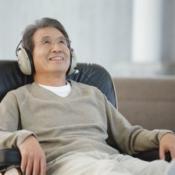 In my therapy practice, I dedicate considerable time to helping people understand what’s happening deep inside of them, in the layers of the nervous system where the conscious mind blurs into the unconscious. This is the part of us that some therapists call the “bodymind.” Understanding the communication of the bodymind creates the ability to “talk” with our inner self: to understand what it is trying to tell us, and even to work with it in its own “language.” It is my experience that the bridging of this gap is ultimately what eliminates most symptoms.
In my therapy practice, I dedicate considerable time to helping people understand what’s happening deep inside of them, in the layers of the nervous system where the conscious mind blurs into the unconscious. This is the part of us that some therapists call the “bodymind.” Understanding the communication of the bodymind creates the ability to “talk” with our inner self: to understand what it is trying to tell us, and even to work with it in its own “language.” It is my experience that the bridging of this gap is ultimately what eliminates most symptoms.
My previous article on self-regulation explains that most symptoms that bring people to therapy are the result of, or strongly related to, difficulties in maintaining this biological balance. It’s important to be aware of this underlying process. After all, we can’t manage things if we’re not aware of them!
This article expands on our understanding of self-regulation. It’s about developing our capacity to be calm, aware, and present, even in stressful situations. For those who have genuinely struggled with this despite repeated and intense efforts, it’s time to stop blaming yourself. As it turns out, this capacity is largely biological. And although we often forget this, biology is the platform upon which social and emotional interactions play out.
Self-regulation of the autonomic nervous system (ANS) can essentially be broken down into two opposing functions: it goes up or it goes down!
In a car, we can press the gas pedal to access more energy, or the brake pedal to slow down or stop. Similarly, the ANS has two parts, or branches: the sympathetic nervous system (SNS), which makes us go up into greater arousal, and the parasympathetic nervous system (PNS), which helps us come down into calmer, less aroused states.
Upregulation means there’s more firing of nerve cells (neurons) along a nerve pathway. So, upregulation of the SNS refers to when this “going up” branch of the nervous system is more active. This “pressing of the gas pedal” increases the amount of energy available in the body. This is why the SNS is often referred to as the “fight-or-flight” nervous system, although it can also upregulate in pleasant situations requiring more energy.
Its opposite, and the focus of this article, is downregulation. Sympathetic downregulation brings down the charge along the pathways of the SNS. At the same time, the PNS upregulates, which helps the SNS downregulate. (We will examine the important exception to this general rule in a future article.)
Both upregulation and downregulation of the SNS are biological processes that we can feel and experience happening within us. Recently, a woman I work with in therapy was able to describe the involuntary muscular tensions, unpleasant pangs, and fluttering sensations of her anxiety (upregulation). She also described the wonderful (downregulation) sensations of her body finally letting go into blissful sleep when she settles down in bed at night.
As most of us can intuit, SNS upregulation can feel terrible when it’s a response to something stressful happening. However, SNS upregulation can also feel great when it’s in response to something fun or exciting: our team scoring a touchdown, or dancing when our favorite song comes on. In contrast, SNS downregulation almost always feels soothing, calming, or relaxing.
I am focusing on SNS downregulation because it’s incompatible with states of anxiety, rage, or stress. Additionally, SNS downregulation keeps the SNS in check, so that it doesn’t “overshoot” and produce too much stress to effectively cope with a problem.
So, then, how do we encourage SNS downregulation? How do we help the body settle down into a state in which it can rest, digest, and repair? For that matter, how do we know when we’re in a downregulated state?
Well, here’s the catch. Downregulating the stress response is an acquired capacity. It’s like a muscle: you have to build it over time in order for it to be strong.
Although infants are born with the capacity for stress response (fussing, crying, etc.), their parasympathetic pathways, which help downregulate the SNS stress response, are not online at birth. This means babies can go up, but they can’t come down on their own. (They will go into a “freeze” state if ignored long enough; this looks calm, but it really isn’t.) The baby’s nervous system develops the ability to calm down through thousands and thousands of supportive, soothing interactions with caregivers. At first, the caregiver is essentially functioning as the child’s parasympathetic nervous system. The development of this “braking system” continues throughout childhood, through continued positive interactions that meet the child’s needs.
There are many situations in which a child may not receive enough soothing in order to learn to downregulate sufficiently. These situations are not always the fault of the parents. Perhaps the child’s mother had a lot of her own unmanaged anxiety, was depressed, and/or experienced posttraumatic stress. Or maybe the family lived in poverty, with constant stressors impacting everyone’s sense of safety. Perhaps someone in the family passed away or suffered a major illness, rendering them unavailable for care. Maybe the child grew up in wartime or, unbeknownst to their parents, was frequently bullied at school.
Great things happen when we are parasympathetically dominant. Our breath is full, slow, and deep. The digestive system works well. The body can focus on repair, including reduction of inflammation, tissue repair, and hormone production. Subjectively, people feel fully present and alive. Many report feeling a pleasant softness and warmth, perhaps even throughout their bodies.
It’s important to point out that disconnecting from stress is not the same as resolving (downregulating) it. Alcohol and drugs, eating disorders, exercise or sexual compulsion, or even “zoning out” on the internet may make the chronically stuck upregulation of the SNS seem to go away for a time. However, as the people I work with in the therapy room could tell you, it’s not the same as sinking into a lovely, full-body sense of calm and relaxation.
Great things happen when we are parasympathetically dominant. Our breath is full, slow, and deep. The digestive system works well. The body can focus on repair, including reduction of inflammation, tissue repair, and hormone production. Subjectively, people feel fully present and alive. Many report feeling a pleasant softness and warmth, perhaps even throughout their bodies. When the SNS is on “standby” and the PNS is more active, people have a “buffer” for stress. They have energy to get through their day, but they can stay calm and present in challenging situations.
One of my first tasks in therapy is to assess and support the person’s ability to downregulate their stress responses. After they are provoked by something, how quickly and smoothly does their system deactivate? Are they still bothered by a small aversive event hours or days afterward?
Here’s a vital point often overlooked by therapists who haven’t had sufficient training in this area: In therapy, it is essential to make sure the person has the ability to downregulate the stress response before going into highly stressful material. In other words, you should never go into material that’s overwhelming, because overwhelming inherently means it’s bigger than your capacity to deal with it. So instead of the issue resolving, more symptoms arise. The way around this is to first support the capacity for downregulation. Then, only after this “braking system” is on board, take the difficult material a small bit at a time.
If someone doesn’t have a strong enough ability to come out of the stress response, how can they develop it?
- Therapy: Working with downregulation of the stress response can be tricky, as it involves the deepest survival energies of the body. It is advisable to work with a therapist who has extensive training in this area. Remember, SNS downregulation was originally designed to come online under the guidance of another person (usually a parent) whose nervous system is well-developed.
- Relaxation: Some people benefit from seeking activities or situations that cause the relaxation response and then deliberately spending time “feeling into” the resulting good sensations in their body. However, in relaxation states, some people experience a rebound in tension, stress, or anxiety. This is called “relaxation-induced anxiety” (RIA) or, in severe cases, “relaxation-induced panic.” In my experience, people with RIA are well served by working with a trained practitioner.
- Physical exercise: Exercise is often helpful, as it tends to burn off excess SNS charge and encourage the production of endorphins. Exercise promotes good mood, self-esteem, and a sense of accomplishment.
- Meditation: There are many forms of meditation, some of which specifically aim to produce downregulated states. However, in my experience, meditation can be unhelpful for some people who have a lot of traumatic response stored in their nervous systems. In these cases, their nervous systems simply won’t cooperate, and those around them may not have the awareness or tools to work with this issue.
- Resonance: Simply put, resonance is the feeling you get from being around another person or other living being. I usually explain it by asking people to think of how they feel when they place their open palm onto the rib cage of a calm, happy dog. That feeling of warmth, relaxation, and well-being is a downregulatory feeling obtained via resonance with the dog’s nervous system. Of course, when others around us are tense, our bodies tend to pick up on that and become tense too. Thus, being around stressed, anxious, or angry people is usually the opposite of what’s needed to develop SNS downregulation.
In summary, the ability to go within and really settle oneself is developed during infancy and childhood. This capacity to downregulate stress states is important in maintaining health, relationships, and happiness. Those whose life circumstances didn’t permit development of this capacity during childhood can still develop it through awareness and work with a skilled professional.
References:
- Dychtwald, K. (1986). Bodymind. New York, NY: Pantheon Books.
- Hamblin, J. (2012). Relaxation-induced anxiety. The Atlantic. Retrieved from http://www.theatlantic.com/health/archive/2012/11/relaxation-induced-anxiety/265313
- Moore, M., Brown, D., Money, N., & Bates, M. (2011). Mind-body skills for regulating the autonomic nervous system. Defense Centers of Excellence for Psychological Health and Traumatic Brain Injury. Retrieved from http://www.dcoe.mil/content/Navigation/Documents/Mind-Body%20Skills%20for%20Regulating%20the%20Autonomic%20Nervous%20System.pdf
- Sharma, A., Madaan, V., & Petty, F. D. (2006). Exercise for mental health. National Center for Biotechnology Information. Retrieved from https://www.ncbi.nlm.nih.gov/pmc/articles/PMC1470658
- Yuan, J., McCarthy, M., Holley, S., & Levenson, R. (2010). Physiological down-regulation and positive emotion in marital interaction. UC Berkeley Information Services and Technology. Retrieved from http://www.learningace.com/doc/1047040/bc95860e894457e838c865c3b7297551/206-physio-down-regulation-and-posemo-in-couples

The preceding article was solely written by the author named above. Any views and opinions expressed are not necessarily shared by GoodTherapy.org. Questions or concerns about the preceding article can be directed to the author or posted as a comment below.

 Tuning In: Mindful Music Listening to Reduce Stress
Tuning In: Mindful Music Listening to Reduce Stress When You've Had Enough: Knowing Your Stress Threshold
When You've Had Enough: Knowing Your Stress Threshold 5 Ways Nature Can Help You Feel Better
5 Ways Nature Can Help You Feel Better

Please fill out all required fields to submit your message.
Invalid Email Address.
Please confirm that you are human.
Leave a Comment
By commenting you acknowledge acceptance of GoodTherapy.org's Terms and Conditions of Use.